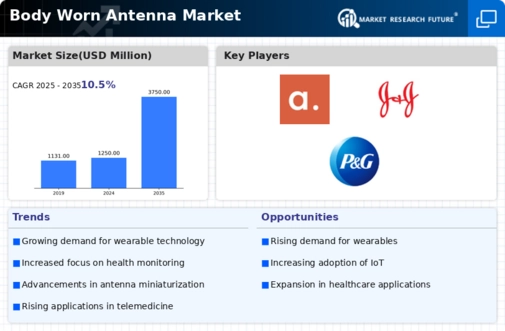Growing Demand for Wearable Technology
The increasing consumer interest in wearable technology is a primary driver for the body worn-antenna market. As individuals seek devices that enhance their daily lives, the integration of antennas into wearables becomes essential. The market for wearable technology in the US is projected to reach approximately $60 billion by 2025, indicating a robust growth trajectory. This surge is likely to propel the demand for body worn antennas, as they are crucial for connectivity and data transmission in these devices. Furthermore, the rise of fitness trackers and smartwatches, which often incorporate health monitoring features, underscores the necessity for efficient body worn antennas. As consumers become more health-conscious, the body worn-antenna market is expected to benefit from this trend, as manufacturers strive to create innovative solutions that meet the evolving needs of users.
Integration of IoT in Wearable Devices
The integration of Internet of Things (IoT) technology into wearable devices is emerging as a key driver for the body worn-antenna market. As IoT applications proliferate, the need for efficient communication between devices becomes paramount. Body worn antennas are essential for facilitating this connectivity, enabling wearables to transmit data seamlessly to other IoT devices and platforms. The US IoT market is projected to reach approximately $1 trillion by 2025, indicating a significant opportunity for the body worn-antenna market to expand. This integration not only enhances the functionality of wearable devices but also opens new avenues for data collection and analysis. As industries increasingly adopt IoT solutions, the demand for body worn antennas that can support these applications is likely to grow, driving innovation and development within the market.
Advancements in Communication Technologies
The rapid evolution of communication technologies significantly influences the body worn-antenna market. With the advent of 5G technology, the demand for high-performance antennas that can support faster data transmission and improved connectivity is on the rise. The body worn-antenna market is poised to capitalize on this trend, as devices equipped with advanced antennas can offer enhanced functionalities. The US telecommunications sector is investing heavily in 5G infrastructure, with projections indicating that the market could exceed $300 billion by 2025. This investment is likely to drive innovation in antenna design and integration, leading to more efficient and compact body worn antennas. As communication technologies continue to advance, the body worn-antenna market will likely see increased adoption across various sectors, including healthcare, fitness, and personal safety.
Rising Adoption in Healthcare Applications
The growing adoption of wearable technology in healthcare applications serves as a crucial driver for the body worn-antenna market. With an increasing focus on remote patient monitoring and telehealth solutions, the demand for devices that can accurately transmit health data is surging. The healthcare wearable market in the US is expected to reach $30 billion by 2025, highlighting the potential for body worn antennas to play a pivotal role in this sector. These antennas enable devices to communicate vital health information in real-time, facilitating timely interventions and improving patient outcomes. As healthcare providers seek innovative solutions to enhance patient care, the body worn-antenna market is likely to benefit from this trend, as manufacturers develop antennas that meet the specific requirements of medical applications.
Increased Focus on Personal Safety and Security
The heightened emphasis on personal safety and security is a significant driver for the body worn-antenna market. As concerns about safety grow, individuals and organizations are increasingly adopting wearable devices that incorporate body worn antennas for real-time communication and location tracking. The market for personal safety devices is expected to grow at a CAGR of around 15% through 2025, reflecting a strong demand for solutions that enhance security. Body worn antennas play a crucial role in enabling these devices to function effectively, providing reliable connectivity for emergency services and personal alerts. This trend is particularly relevant in sectors such as law enforcement and security, where body worn cameras and communication devices are becoming standard. Consequently, the body worn-antenna market is likely to experience substantial growth as it aligns with the increasing demand for safety-oriented technologies.














Leave a Comment